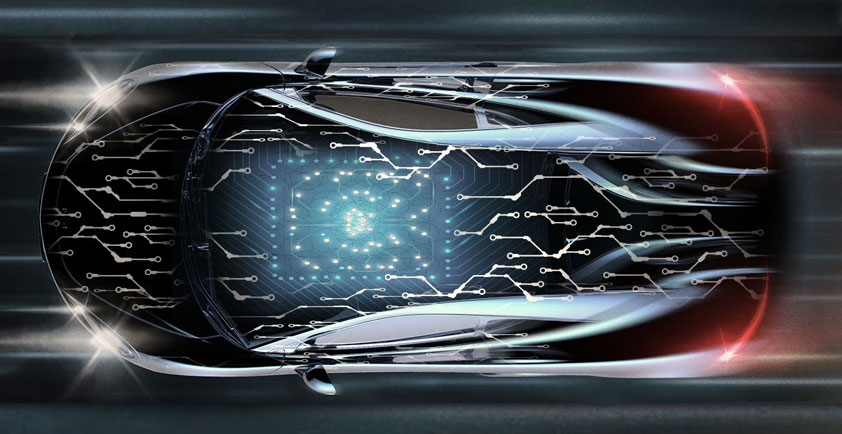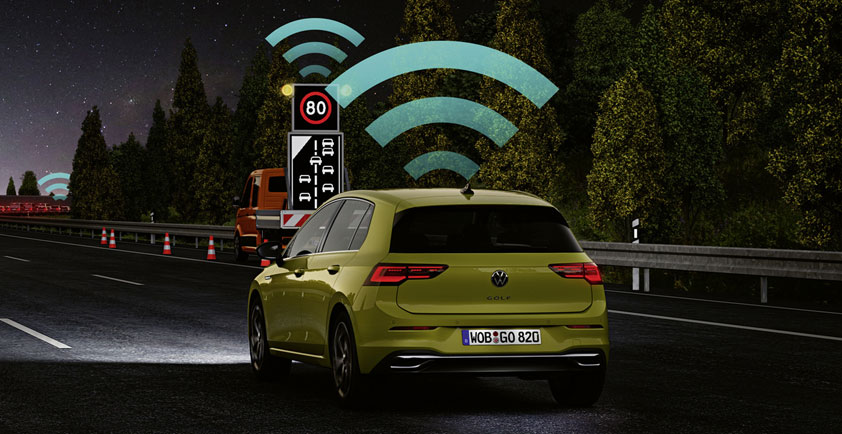

DESIGNING AT THE EDGE FROM IOT TO AUTOMOTIVE
Edge computing cuts across the IoT, from home and work to the most complex of all – the vehicle. Coupled with rising digitization that leads to everything connected, high-performance edge compute platforms are transforming ecosystems and the development landscape. Joining Kurt Sievers, NXP President, is a cloud-edge services provider, an innovative industrial charging company and an emerging automaker who share insights on smart, secure real-time edge platforms that cross IoT markets to learn preferences, anticipate needs, dynamically respond – and ultimately lead to seamless connected experiences everywhere. Special guest Todd McNeal, Fire Chief for Twain Harte, explains how technology is used for fire fighting.
SELF-DRIVING CARS: WHAT’S THE PAYOFF FOR CARMAKERS?
Most are familiar with the safety and convenience aspects that self-driving cars could offer, but if carmakers pour billions into self-driving cars – what’s in it for them? Influencers from disruptive automotive companies offered for their views on safety, cost, and the payoff for carmakers during a special panel discussion at the NXP Connects event in Silicon Valley.
The long, winding road to win consumer trust
The race to get self-driving cars on the road has already seen devastating setbacks – namely the 2018 Uber incident, where a 49-year-old woman was tragically killed by a self-driving car. This is where the really tough questions sit, as we can’t ignore the fact that 1.3 million people are killed every year in car accidents – with 95% of them due to human error. Building safe autonomous cars appears to be the best chance we have in making our roads safer as carmakers aim to reduce that statistic.
Self-driving cars need to be safer than a human driver for people to trust them. And that’s where the industry’s stuck – as all carmakers are asking themselves the same question.
What is “safe enough”, and how much will it cost carmakers to achieve it?
“I think it will be an order of magnitude, which means ten times safer than a human in order for the general public to accept,” Wesley Shao, Director, Autonomous Driving at BYTON said.
What is the industry’s MVP to aim for? Carmakers and stakeholders would be feeling much more confident in their quest to build self-driving cars if they knew how safe they need to be for people to use them – let alone buy them.
Do self-driving cars need to be five times safer than a human driver? Or ten times safer? Plus, how many millions are going to be spent in order to achieve that number? The cost of technology will go down in time, as it always does – and with this, the industry is hoping that the safety level goes up. Then, the race for all carmakers to get their self-driving car on the market is blown wide open.
Vijay Albuquerque, Senior Vice President of Strategic Initiatives at Luminar suggests that it will take a strong focus on safety first. And then cost will come with scale.
Where will carmakers make their money back?
With billions being spent – it’s inevitable that a market-ready self-driving car will be available within the next few decades. However, this wait could turn out to be a good thing for carmakers’ bottom line – as it allows more time for consumer habits to change. A major shift has happened in the automotive industry in recent years, and the trend is only growing.
It’s no longer all about the driver. We have entered the passenger era
“This is a pivotal moment in the industry,” Rachad Youssef, VP Software Product Management at NIO, shared, “I think of it as when flat panel televisions were introduced. It really is going to change the way people perceive value.”
Car ownership isn’t as important or popular as it used to be. Even today’s car owners, regardless of how much they enjoy driving their car, may already depend on using ride-sharing services when they wish to stay out late, drink alcohol or just don’t fancy driving for whatever reason.
Self-driving cars appeal to a whole new customer base across multiple income levels – giving access to the elderly, children, and everyone in the world without a driving licence. Suddenly, carmakers have a new audience. And that’s just looking at self-driving car sales; many industry leaders can see their payoff coming back to them through more ways beyond car sales.
The payoff for carmakers may come from multiple directions
Alex Tan, NXP VP & GM of Automotive Ethernet Solutions, has no doubt that carmakers will make their money back. “What’s being built with the autonomous car, goes far beyond just the vehicles. You can immediately start thinking about other physical objects: things like drones, and other devices that are acting autonomously.” He adds, “but this learning and the ability to use this, and to do this with safety, goes into systems of control, for cities, and financial things – all sorts of new and very exciting areas are being opened up by this technology.”
The next few decades will see twists and turns as the technology develops. And people’s view towards car ownership and ride-share services will continue to shift. Yes, the challenges ahead for carmakers are incredibly tough – but the ones who stay in the race to get self-driving cars on the road have the chance to win much more than their money back.
CAN SILICON VALLEY REALLY CRACK THE AUTO INDUSTRY CODE?
A whole new wave of innovative mobility startups appeared soon after Tesla disrupted the long-established automotive industry. Now the hype phase is over as all eyes look to see if Silicon Valley can crack the complex auto industry code.
From Demand to Design
At NXP Connects in Silicon Valley, We brought together a panel of industry experts from Rivian, Baidu, Continental and DeepScale to discuss the challenges and opportunities ahead, as the world watches on to see if Silicon Valley can navigate the pivotal changes the auto industry is expecting.
Silicon Valley is well into the race, but the finish line may be blurry
Today, “cracking the auto industry code” seems a long way off – and we don’t really know what success looks like yet or what consumers want from an autonomous car. Every region has a different perspective on the value proposition a vehicle offers, and how technology should be built and adopted. So, the thought of creating one global solution might not be realistic – and achieving anything close to it won’t happen if automotive companies are working in an echo chamber.
“‘The code that they’re cracking’ is actually changing in terms of what the expectations are from the consumers,” Leland Key, SVP Global Automotive Sales & Marketing at NXP shared.
It’s going to take many of the world’s sharpest minds working together – looking far beyond the cities they live in – to get close to creating a product that “works” across the world. Achieving any groundbreaking autonomous solution will require collaboration – which is why many believe Silicon Valley may achieve major breakthroughs in the auto industry before everyone else.
“There are certain things which cannot be achieved by just 10, 20, 30, 40, 100 people. It requires this community setting. Linux is a great example. All of that came together to allow a platform that is being used in millions of millions of devices today,” Sethu Gopal, Sr. Director, Connected Car & Digital Experience at Rivian shared.
Silicon Valley’s culture of collaboration could be the difference
“Who in the world knows how to handle data better than Silicon Valley? And that’s, where I think the valley comes in – breaking that auto industry code of, you know, trying to do everything in-house versus trying to do outside their ecosystem,” Anil Rachakonda, Vice President, co-pace at Continental said.
People working for tech companies in Silicon Valley want to be there. It may be expensive, crowded and overwhelming at times – but the people that are working in Silicon Valley are exactly where they want to be. It offers a unique, casual and accessible opportunity for collaboration that few cities in the world can rival. No ambitious CEO wants to wait days or weeks to get a chance to talk to someone they’re interested in working with, but that’s the reality for most cultures. Silicon Valley doesn’t have these barriers, which is why we expect to see some compelling partnerships develop.
Automotive companies may be forced to collaborate to keep up with consumer demand
The automotive industry is making a transition from hardware to software as we see companies like Tesla put millions of lines of code into their vehicles. However, the majority of automotive companies don’t have the expertise or code base … yet. This may lead some to seek outside help to ensure that they stay in the race to get autonomous vehicles on the road.
Is the auto industry still a viable market to succeed?
Billions have been spent and nobody is expecting their money to return within the next decade, at least. Tesla has made impressive breakthroughs in the industry – yet it still reports huge losses. It’s easy to understand why automotive companies may not be feeling too optimistic about investing heavily in autonomous cars today.
Despite the uncertainty ahead, startups are still raising money to build autonomous cars as it’s clear that the world wants them; China is already building highways to prepare for autonomous vehicles. Plus, there has been a shift in the industry: car owners are driving less due to ride-sharing services become ingrained in big city culture. This can only be a good sign of what’s to come.
Even with the major setbacks the industry has seen, a collaborative network continues to expand across the industry with startups, semiconductor companies, automotive suppliers and established carmakers – which makes us wonder, what type of partnerships will evolve?













